
Tourism Places In churuBest time to visit September to March churu is the desert city a place of historic importance. The town is said to have been found by a Jat named Chuhru in 1620 AD. churu, like an oasis, situated in the middle of the shifting golden sand dunes, opens the gate to the great desert of Thar. churu is located in Rajasthan state, in northwestern India. The town has a hospital and a college affiliated with the University of Rajasthan. churu district (16,829 sq. km) comprises a semi-arid sandy plain, watered only by the Katli River in the northeast. The city has a magnificent fort which is believed to have been built by Thakur Khushal Singh in the year 1739 AD. The proud fort stands in the middle of the town where it is said that the brave Thakur Sheoji Singh tried to defend its honour by firing silver canon balls at the attacking army of the Raja of Bikaner. churu gives the enchantment of its past glory and treasure to the visitors while one walks through the meandering streets, lined either sides by the largest havelis in the area. There are beautiful temples, chhatries(cenotaphs), the fort, the Johra (water tank) and wells which are all decorated with bright multicoloured wall paintings in various subjects. The city also has a museum named 'Nagarshree'. Mantri Haveli churu The Mantri Haveli, churu is one of the most beautifully designed Havelis in Rajasthan in India. Nestled in the rugged terrain of churu in Rajasthan, the Mantri Haveli, churu attracts tourists from all over. Indianholiday.com offers online information on Mantri Haveli, churu and other tourist attractions of Rajasthan and other parts of India. A few kilometers from Jaipur, churu in Rajasthan is the ideal destination if you wish to take a glimpse of the Havelis of Rajasthan. The Mantri Haveli, churu reflects the rich grandeur and splendor of the Rajput era. One of the major tourist attractions of Rajasthan, the Mantri Haveli, churu attracts tourists from all over to Rajasthan. The Mantri Haveli is truly a beautiful symbol of Rajput grandeur and beauty. In the Mantri Haveli, churu you can get to see beautiful paintings and exquisite mirror work that brings travelers from all over. churu located in Rajasthan in the north western part of India was founded by the Jats. From magnificent Havelis to the palatial mansions, churu in Rajasthan is one of the most beautiful destinations for history lovers and art lovers. Located in the heart of Shekhawati, the mansions and forts of churu in Rajasthan are one of the major tourist attractions of Rajasthan. 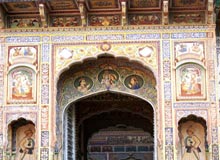 Mantri Haveli, churu was built in the 18th century and is completely covered with paintings. From exotic images to beautiful and unique silhouettes the paintings are simply a class apart. One of the oldest Havelis in churu, the Mantri Haveli is an art gallery. Dedicated to one of the ministers of the royal family the Mantri Haveli in churu attracts tourists for its beauty and uniqueness.
From floral swirls, motifs, and excellent mirror work, to balconies and alcoves, the exquisite artistry of the Rajputs are explicitly reflected in its artwork as well as architecture. From lavish ornamentation, spacious courtyards to sprawling areas, the Mantri Haveli, churu attracts people from all over.
However the front facade is completely worn out and you can feel the medieval aura and ambience once you enter inside the Mantri Haveli, churu.
Mantri Haveli, churu was built in the 18th century and is completely covered with paintings. From exotic images to beautiful and unique silhouettes the paintings are simply a class apart. One of the oldest Havelis in churu, the Mantri Haveli is an art gallery. Dedicated to one of the ministers of the royal family the Mantri Haveli in churu attracts tourists for its beauty and uniqueness.
From floral swirls, motifs, and excellent mirror work, to balconies and alcoves, the exquisite artistry of the Rajputs are explicitly reflected in its artwork as well as architecture. From lavish ornamentation, spacious courtyards to sprawling areas, the Mantri Haveli, churu attracts people from all over.
However the front facade is completely worn out and you can feel the medieval aura and ambience once you enter inside the Mantri Haveli, churu.
Salasar Balaji 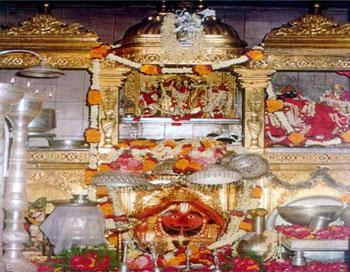 Salasar houses the famous Balaji Temple which attracts a large number of devotees from all over India. Shri Hanumanji, the famous Hindu deity of vigour and loyalty, having been pleased by the devotion and worship of Shri Mohan Das Mahraj, appeared in the form of a statue on Saturday, Shrawan Sukla Navami, V.S. 1811 at Asota village.
The statue was brought to Salasar where the temple was built. Later, the devotees added more buildings to the main temple. Two large fairs are held on Chaitra(April) and Ashwin purnimas(October) every year. Lacs of devotees from all over the country and abroad come and offer their wish before the great Hanumanji in the temple and have 'Darshan' of Shri Balaji throughout the year.
Salasar houses the famous Balaji Temple which attracts a large number of devotees from all over India. Shri Hanumanji, the famous Hindu deity of vigour and loyalty, having been pleased by the devotion and worship of Shri Mohan Das Mahraj, appeared in the form of a statue on Saturday, Shrawan Sukla Navami, V.S. 1811 at Asota village.
The statue was brought to Salasar where the temple was built. Later, the devotees added more buildings to the main temple. Two large fairs are held on Chaitra(April) and Ashwin purnimas(October) every year. Lacs of devotees from all over the country and abroad come and offer their wish before the great Hanumanji in the temple and have 'Darshan' of Shri Balaji throughout the year. Ratangarh 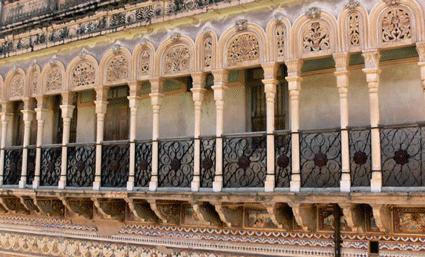 The mammoth fort is an important attraction of the state, built in 1820 AD by the Raja of Bikaner- Ratan Singh, is situated on the Agra-Bikaner Highway.
The market place is in the shape of a cross suggesting that the city was planned before construction. An array of stately havelis can be seen around the clock tower at the main crossing.
The mammoth fort is an important attraction of the state, built in 1820 AD by the Raja of Bikaner- Ratan Singh, is situated on the Agra-Bikaner Highway.
The market place is in the shape of a cross suggesting that the city was planned before construction. An array of stately havelis can be seen around the clock tower at the main crossing. Kothari and Surana Haveli 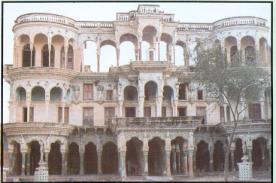 A group of handsome painted havelis built by two prominent Oswal Jain merchant families, the Kothari and Surana clans.
Amongst them are Malji Ka Kamra (Malji's Haveli), an exotic stucco extravagaza built by Malaji Kothari around 1925 and the massive Surana Double Haveli, the six-storeyed, enormous building has artistic windows and elegant doors that are more than 1,100 in number built in the 1870s.
Chhatries:
churu has some good memorial domes, mostly raised to rich merchants, north of the town. Historically the most significant is Aath Kambh Chhatri (Eight Pillar Dome) west of the vegetable market.
Its base has been virtually buried by windblown sand. The interior is covered with murals, one detail depicting an early European mercenary on foot, bearing a musket. Further north are chhatris of the Mantri, Bagla and Lohia merchant families.
A group of handsome painted havelis built by two prominent Oswal Jain merchant families, the Kothari and Surana clans.
Amongst them are Malji Ka Kamra (Malji's Haveli), an exotic stucco extravagaza built by Malaji Kothari around 1925 and the massive Surana Double Haveli, the six-storeyed, enormous building has artistic windows and elegant doors that are more than 1,100 in number built in the 1870s.
Chhatries:
churu has some good memorial domes, mostly raised to rich merchants, north of the town. Historically the most significant is Aath Kambh Chhatri (Eight Pillar Dome) west of the vegetable market.
Its base has been virtually buried by windblown sand. The interior is covered with murals, one detail depicting an early European mercenary on foot, bearing a musket. Further north are chhatris of the Mantri, Bagla and Lohia merchant families. Black Buck Santuary Tal Chhapar  Talchhapar Sanctuary is situated in churu district of North-Western Rajasthan and is famous for endangered black-buck. Other wild animals found in the sanctuary are chinkara, fox, juangle cat, rojra along with many resident and migratory birds. It lies on the way of migratory pass of many birds and therefore it is also popular with bird lovers.
Talchhapar area was a game reservoir for the erstwhile Maharaja of Bikaner State and was declared a reserved area for the protection of wild animals and birds in the year 1962. Total area of Talchhapar Sanctuary is 719 hectare. The sanctuary area is mostly covered by grasses with a very few and sparse trees of Khejri, Salvadora, Ber, Ker and Neem.
A large number of migratory birds visit this region during the month of September. Tourists can easily spot sparrow hawk, Ben harrier, Montague's harrier, imperial eagle, marsh harrier, pale harrier, tawny eagle, skylark, short toed eagle, sparrow hawk, ring drove, crested lark, brown dove, blue jay, black ibis, green bee eaters, demoiselle cranes, blue jays and cranes.
Talchhapar Sanctuary is situated in churu district of North-Western Rajasthan and is famous for endangered black-buck. Other wild animals found in the sanctuary are chinkara, fox, juangle cat, rojra along with many resident and migratory birds. It lies on the way of migratory pass of many birds and therefore it is also popular with bird lovers.
Talchhapar area was a game reservoir for the erstwhile Maharaja of Bikaner State and was declared a reserved area for the protection of wild animals and birds in the year 1962. Total area of Talchhapar Sanctuary is 719 hectare. The sanctuary area is mostly covered by grasses with a very few and sparse trees of Khejri, Salvadora, Ber, Ker and Neem.
A large number of migratory birds visit this region during the month of September. Tourists can easily spot sparrow hawk, Ben harrier, Montague's harrier, imperial eagle, marsh harrier, pale harrier, tawny eagle, skylark, short toed eagle, sparrow hawk, ring drove, crested lark, brown dove, blue jay, black ibis, green bee eaters, demoiselle cranes, blue jays and cranes. Places of worship and sites There are many temples in the city mostly dedicated to Hindu deities - Hanuman, Balaji Babosa, Bhagwan Ram, Krishana, Satyanarain, Durga Mata, Santoshi Mata Local Deities Gogaji, Ramdeoji,Veer Vigga Karni Mataji, Shitala Mata and a few Mosques as well as a Digambar Jain Mandir. Marda SatiI Mandir Balaji Babosa Temple Digambar Jain Temple Upahshara Jatiji Hanuman Balaji temple Ganesh Temple Shyam Temple Ram Mandir Punchmukhi Balaji Shaniji Gogaji Shitala Mata Bhaninath Muth Dharam Stupa [All religion Tower Temple]. Shri Akshay Shakti dham, parsneu(ratangarh) Shri Ram Mandir Dulrasar, Jiwani Sakati Ashram (Balaji Dham) Gurukul Vidyalaya Bhagwati Bhadrakali Shaktipeeth Ashram, Rajaldesar Dandiswami Jogendrashram, Rajaldesar Another world famous site is a temple dedicated Balaji Babosa Maharaj who is believed to be an incarnation Lord Hanuman. An annual fair is held every year in the month of December, it is a week long jubilation held to celebrate the coronation ceremony of Shri Babosa Maharaj by Lord Hanuman. The fair is named after the ceremony as Mingesar Mela churu fort Famous FORT of churu from which silver cannon balls were fired Havelis 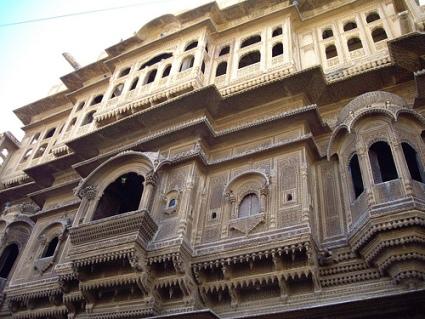 The famous wealthy Marwari merchants of the town, having business connections all over India, added to its splendour by building beautiful majestic havelis, made of lime and brick and decorated them by the best of the frescoes on the facade as well as inside of the rooms. The best of the masons and 'Chitera' or painters were employed to decorate these buildings. Initially, the Chiteras practised dry and wet methods using mineral and vegetable colours. Later on, around in 1860's they made brighter and colorful paintings with the help of chemical colours. Some merchants, the Mantries, Suranas & Kotharis got few rooms painted in gold with extensive mirror work. The prosperity of churu reached its zenith in 18th century when the atmosphere of peace and security prevailed and the caravans passed through. Consequently, the business of wool, silk, opium and spices flourished. The merchants moved away to the British India and onwards to Calcutta and other business centers in central India. They made a lot of money using their unique business acumen and decided to raise the palatial houses for their families in churu.
The famous wealthy Marwari merchants of the town, having business connections all over India, added to its splendour by building beautiful majestic havelis, made of lime and brick and decorated them by the best of the frescoes on the facade as well as inside of the rooms. The best of the masons and 'Chitera' or painters were employed to decorate these buildings. Initially, the Chiteras practised dry and wet methods using mineral and vegetable colours. Later on, around in 1860's they made brighter and colorful paintings with the help of chemical colours. Some merchants, the Mantries, Suranas & Kotharis got few rooms painted in gold with extensive mirror work. The prosperity of churu reached its zenith in 18th century when the atmosphere of peace and security prevailed and the caravans passed through. Consequently, the business of wool, silk, opium and spices flourished. The merchants moved away to the British India and onwards to Calcutta and other business centers in central India. They made a lot of money using their unique business acumen and decided to raise the palatial houses for their families in churu.There is yet another haveli whose creation does not lie in grand plans but a small plan blown out of proportion. This haveli commonly known as 'Jahaz Kothi' (jahaz literally meaning ship; but in Hindi airplanes are also popularly referred by this term). The builder of this kothi, Malchand Nagwan, wanted his home to be a little different so wished to build a small air plane on his terrace, but the constructer being a great fan of the man wanted big things for his big man so instead of modesty he chose flamboynace- and today there hangs an airplane of the size of a helicopter on this kothi! And thus the name'Jahaz Kothi', a kothi known more by its design than by the name of its owners and builders. The Marda (Maheshwari),Agarwals, Kaklasaria, Lakhotia, Bagla, Poddar, Kothari, Baid, Banthia, Soni ,Surana, Heerawat, Jain, ( parakh ),Sharma, Vyas,Pareek,Pandia, Bohra, Saini, KALLA are the some of the surnames of the people from the town. churu is an important town in the history.  The havellies were impressively decorated with Belgian etched kaleidoscopic glasses in many shapes and designs. Their intricate designs and their carved woodwork doorframes are admirable. Their arch shaped gateway with provision for two seats on both the sides and their stipulations for privacy in the inner courtyard for the womenfolk are of note. Special care was taken about the security of the inmates and thus they used to make thick and blind outerwalls in the earlier times. Only the upper stories had windows small and big neatly decorated with wooden inlaid doors.
The havellies were impressively decorated with Belgian etched kaleidoscopic glasses in many shapes and designs. Their intricate designs and their carved woodwork doorframes are admirable. Their arch shaped gateway with provision for two seats on both the sides and their stipulations for privacy in the inner courtyard for the womenfolk are of note. Special care was taken about the security of the inmates and thus they used to make thick and blind outerwalls in the earlier times. Only the upper stories had windows small and big neatly decorated with wooden inlaid doors.These Havellies are best known for their colorful murals {wall paintings} within fresco artwork. The variety of the subjects incorporated in these murals can be of great interest for any Research Scholar. Once can discover the portraits and details of Hindu mythological gods such as Raja Ram along Sita, Hanuman, the Bhairav, Goddess Kali and the Romantic and artistic depiction's of Lord Krishna along with Radha and other maids. The pre- historic Epic Ramayana's portraitures in golden n works also find place on many ceilings of the massive temples & Havelis and the domes of the Chhatris. Wall paintings of a sea Vessel made in Germany, Dhola-Maru and Sassi-Punnu {the Rajasthani versions of Romeo-Juliet}. The Hess Christ, Railway Station to the center plan of a city, Jesus smoking a cigar, a Railway Train, a Limousine etc., etc. are the other themes that can be noticed among many. AT some sites neatly placed one may find erotic scenes as well. Many people from churu are now settled in Mumbai, Kolkatta and are engaged in trade, building, construction and export-import and other businesses. Some well known business houese are MARDA GROUP,Surana group, Bagla group business houses,. Some people from churu presently reside in Bangalore, and Ahmedabad too. They keep regular contact with churu through social and religious functions. Monuments of churu Fort churu Ghantaghar Dharam Stup Sethani Ka Johra Dakira Jhora Naath Ji Ki Bungli Nagar Shree Bhavan Sarvahitkarini Sabha Bhawan Mata ji ka Tiba Shiv Bhagwan ji ka Tiba Excursions from churu Dudhwa Khara (36Km.) It is an historical village which lies on Thar desert. The village has enticing topography and have huge beautifully designed havelis. You could enjoy the rural life and camel safaris in this Dudhwa Khara. Tal Chhapar 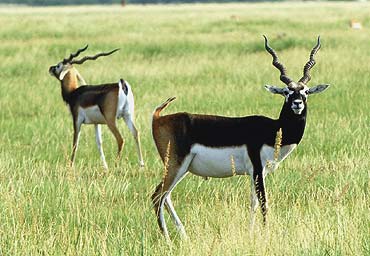 Tal Chhapar is a small and away from churu only 100km. enticing lake and harbours some endangered species like black bucks and some migratory birds. The lake is 100 km away from churu.
Tal Chhapar is a small and away from churu only 100km. enticing lake and harbours some endangered species like black bucks and some migratory birds. The lake is 100 km away from churu. Sardar Shahar (46Km.) Just 46 kms from churu, Sardar Shahar is an enchanting desert down with beautiful intricate havelis adorned with colourful wall paintings and carved wood work. Surana Haveli This is a six storeyed edifice with an artistic windows and elegant doors. The haveli have more than 1100 doors. Dudhwa Khara(36Km.) It is an historical village which lies on Thar desert. The village has enticing topography and have huge beautifully designed havelis. You could enjoy the rural life and camel safaris in this Dudhwa Khara. Famous Artisans of the churu Town 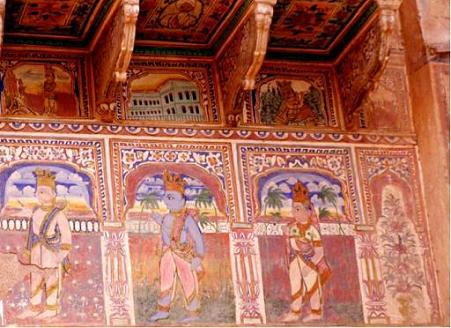 Though a town with no handicrafts to boast of, churus offers some excellent sandalwood. In churu, Malchand Jangid, a carpenter used to make sandalwood almonds that were hinged in wood. When opened they revealed a tiny deity of your choice. Ram Ratan Sharma, another expert in this craft, had first started out by carving cakes of cheap soap until he came upon his grand mother's coffer of sandalwood. With tools that he made himself, he created intricate objects lockets, flowering plants with hidden cells that open to reveal sandalwood gods or a village scene. churu is also famous for its drummers, especially during the festivals of Holi and Muharram.
Though a town with no handicrafts to boast of, churus offers some excellent sandalwood. In churu, Malchand Jangid, a carpenter used to make sandalwood almonds that were hinged in wood. When opened they revealed a tiny deity of your choice. Ram Ratan Sharma, another expert in this craft, had first started out by carving cakes of cheap soap until he came upon his grand mother's coffer of sandalwood. With tools that he made himself, he created intricate objects lockets, flowering plants with hidden cells that open to reveal sandalwood gods or a village scene. churu is also famous for its drummers, especially during the festivals of Holi and Muharram. |

